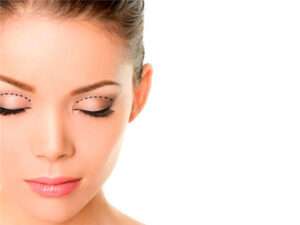Eyelid Aesthetics
UPPER EYELID AESTHETICS
Drooping of the upper eyelids can be present from birth or develop over time. The most frequent cause is reduced function of the eyelid muscles. In children, early surgery may be necessary to prevent lazy eye (amblyopia), or it may be advised before school age to help avoid social challenges. The surgical technique depends on how well the eyelid muscles function. In cases where the muscle strength is particularly weak, especially in congenital conditions, the eyelid may need to be connected to the forehead muscles to lift it. In age-related drooping, ptosis surgery can be performed together with cosmetic eyelid procedures.
LOWER EYELID AESTHETICS
This procedure addresses issues like excess skin, bulging fat pads, and deep tear troughs beneath the eyes. The main goals are to elevate the midface, reposition rather than remove herniated fat, and fill in the tear troughs for a smoother, more youthful look. It can be performed under local anesthesia with sedation. The incision is made along the lash line and follows the natural skin crease, making it barely visible.
Is lower eyelid aesthetics effective for under-eye dark circles?
Yes, this surgery can significantly improve the appearance of dark circles. By removing excess skin and adding fat to hollow areas, the face gains a refreshed, more youthful look.
Should midface lifting be done along with lower eyelid aesthetics?
Yes, combining lower eyelid surgery with midface lifting is highly recommended. It reduces the vertical length of the lower eyelid and helps prevent lower eyelid sagging (ectropion). It also enhances cheek volume and smooths deep smile lines.
Is fat injection recommended during lower eyelid surgery?
Definitely. As we age, facial fat compartments lose volume—particularly in the tear trough area. Including fat injection during surgery helps restore youthful fullness to the face.
What should you pay attention to before lower eyelid surgery?
It’s crucial to stop smoking at least four weeks before the procedure, as smoking affects healing. If you have high blood pressure, continue your medication and consult your doctor to ensure it’s well controlled. Avoid green tea, parsley juice, arugula, leafy greens with blood-thinning effects, and supplements like Q10 and fish oil at least 10 days before surgery. Inform your surgeon of all medications and supplements you’re using.
How long will you need to stay off work after lower eyelid surgery?
Swelling, bruising, and puffiness are normal and usually subside within 10 days. Complete facial definition can take up to three months. Most people can return to work in a week after the stitches are removed and can use makeup and sunscreen.
Should you continue under-eye fillers after lower eyelid surgery?
Generally, fillers are no longer needed. Proper fat repositioning during surgery eliminates the need for future under-eye filler treatments.
How is congenital eyelid drooping treated?
This condition is treated surgically, often depending on the severity of muscle weakness.
What can be done for under-eye dark circles?
Light fillers and various mesotherapy treatments can help brighten and improve the appearance of dark circles.
Does eyelid surgery leave scars?
A small scar remains hidden in the natural eyelid crease, making it unnoticeable when the eyes are open.
Is there any harm in performing eyelid aesthetics with lasers?
No, because eyelid surgery is not performed with lasers—it requires conventional surgical methods.
Which doctor should treat eyelid drooping?
Only qualified plastic surgeons should perform eyelid drooping correction procedures.
Does eyelid drooping resolve on its own?
No, this condition does not improve without medical or surgical intervention.
What are the causes of eyelid drooping?
It can either be congenital (present at birth) or develop later due to aging, trauma, or other conditions.
Are there natural solutions for sagging eyelids?
No natural remedies can effectively correct sagging eyelids—surgery is the only reliable solution.
How is eyelid drooping in infants treated?
If left untreated, drooping eyelids can lead to lazy eye. Mild cases may improve, but moderate to severe cases usually require surgery performed by a plastic surgeon.
How long does eyelid surgery take?
The procedure typically lasts around one hour.
Is eyelid surgery performed under local anesthesia?
Yes, local anesthesia is used, often accompanied by light sedation.
Can eyelid drooping be fixed with exercises?
No, there are no exercises that can correct eyelid drooping. It requires surgery.
What are the symptoms of eyelid drooping?
Common signs include reduced vision and a fatigued look, especially noticeable by the end of the day.
Can a woman who has had heart surgery undergo eyelid surgery?
Yes, but only after clearance from her cardiologist to ensure it’s safe to proceed with the procedure.

